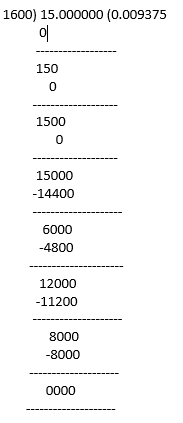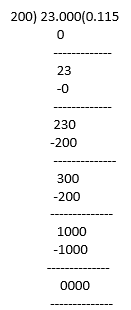NCERT Solutions Class 10 Maths Chapter 1 Real Numbers Exercise 1.4 can be accessed here. We have our own subject experts in preparing these NCERT Maths Solutions for Class 10. They also review these solutions from time to time to modify them to make them easily understandable by the students.
These solutions can be practised easily and help the students to revise quickly. Exercise 1.4, which is the fourth exercise of Chapter 1, Real Numbers in Class 10, explains Rational numbers and their decimal expansion in detail. To make it easy to grasp, the solutions are given step-wise. Not only this, but we have also focused on following all the NCERT guidelines while preparing the NCERT Class 10 solutions.
Download the PDF of NCERT Solutions for Class 10 Maths Chapter 1 – Real Number Exercise 1.4
Access other exercise solutions of Class 10 Maths Chapter 1 – Real Number
Exercise 1.1 Solutions 5 Questions (4 long, 1 short)
Exercise 1.2 Solutions 7 Questions (4 long, 3 short)
Exercise 1.3 Solutions 3 Questions (3 short)
Access Answers of Maths NCERT Class 10 Chapter 1 – Real Number Exercise 1.4
1. Without actually performing the long division, state whether the following rational numbers will have a terminating decimal expansion or a non-terminating repeating decimal expansion.
(i) 13/3125 (ii) 17/8 (iii) 64/455 (iv) 15/1600 (v) 29/343 (vi) 23/(2352) (vii) 129/(225775) (viii) 6/15 (ix) 35/50 (x) 77/210
Solutions:
Note: If the denominator has only factors of 2 and 5 or in the form of 2m ×5n, then it has a terminating decimal expansion.
If the denominator has factors other than 2 and 5, then it has a non-terminating decimal expansion.
(i) 13/3125
Factorising the denominator, we get
3125 = 5 × 5 × 5 = 55
Since the denominator has only 5 as its factor, 13/3125 has a terminating decimal expansion.
(ii) 17/8
Factorising the denominator, we get
8 = 2×2×2 = 23
Since the denominator has only 2 as its factor, 17/8 has a terminating decimal expansion.
(iii) 64/455
Factorising the denominator, we get
455 = 5×7×13
Since the denominator is not in the form of 2m × 5n, 64/455 has a non-terminating decimal expansion.
(iv) 15/ 1600
Factorising the denominator, we get
1600 = 26×52
Since the denominator is in the form of 2m × 5n, 15/1600 has a terminating decimal expansion.
(v) 29/343
Factorising the denominator, we get
343 = 7×7×7 = 73
Since the denominator is not in the form of 2m × 5n, 29/343 has a non-terminating decimal expansion.
(vi)23/(2352)
Clearly, the denominator is in the form of 2m × 5n.
Hence, 23/ (2352) has a terminating decimal expansion.
(vii) 129/(225775)
As you can see, the denominator is not in the form of 2m × 5n.
Hence, 129/ (225775) has a non-terminating decimal expansion.
(viii) 6/15
6/15 = 2/5
Since the denominator has only 5 as its factor, 6/15 has a terminating decimal expansion.
(ix) 35/50
35/50 = 7/10
Factorising the denominator, we get
10 = 2 × 5
Since the denominator is in the form of 2m × 5n, 35/50 has a terminating decimal expansion.
(x) 77/210
77/210 = (7× 11)/ (30 × 7) = 11/30
Factorising the denominator, we get
30 = 2 × 3 × 5
As you can see, the denominator is not in the form of 2m × 5n. Hence, 77/210 has a non-terminating decimal expansion.
2. Write down the decimal expansions of those rational numbers in Question 1 above which have terminating decimal expansions.
Solutions:
(i) 13/3125

13/3125 = 0.00416
(ii) 17/8

17/8 = 2.125
(iii) 64/455 has a non-terminating decimal expansion.
(iv)15/ 1600

15/1600 = 0.009375
(v) 29/ 343 has a non-terminating decimal expansion.
(vi)23/ (2352) = 23/(8×25)= 23/200

23/ (2352) = 0.115
(vii) 129/ (225775) has a non-terminating decimal expansion.
(viii) 6/15 = 2/5

(ix) 35/50 = 7/10

35/50 = 0.7
(x) 77/210 has a non-terminating decimal expansion.
3. The following real numbers have decimal expansions, as given below. In each case, decide whether they are rational or not. If they are rational and of the form, p q, what can you say about the prime factors of q?
(i) 43.123456789
(ii) 0.120120012000120000. . .

Solutions:
(i) 43.123456789
Since it has a terminating decimal expansion, it is a rational number in the form of p/q, and q has factors of 2 and 5 only.
(ii) 0.120120012000120000. . .
Since it has a non-terminating and non-repeating decimal expansion, it is an irrational number.

Since it has a non-terminating but repeating decimal expansion, it is a rational number in the form of p/q, and q has factors other than 2 and 5.
NCERT Solutions for Class 10 Maths Chapter 1 – Real Numbers Exercise 1.4 is the fourth exercise of Chapter 1 of Class 10 Maths. After introducing Real Numbers in Class 9, it is discussed in further detail in Class 10. This chapter explains rational numbers and their decimal expansions. The exercise discusses when exactly the decimal expansion of a rational number is terminating and when it is non-terminating.
- Revisiting Rational Numbers and their decimal expansions – It includes 3 questions, where question 1 has 10 parts, and question 2 has 3 parts.
Key Features of NCERT Solutions for Class 10 Maths Chapter 1 – Real Number Exercise 1.4
- These NCERT Solutions help students solve and revise all questions of Exercise 1.4.
- Students will be able to solve problems more confidently after going through these NCERT Maths Solutions.
- They not only help in revising the concept but also make students score well in exams.
- They follow NCERT guidelines which help in preparing the students accordingly.
- They contain all the important questions for the examination.





Good
good solution
thank u so much